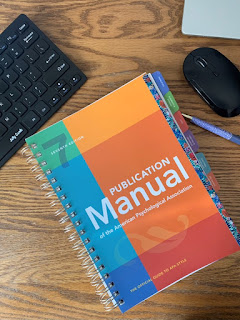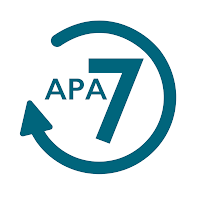Embracing the Learning Process: Transitioning from APA 6 to APA 7
It’s been 10 years since I first began my journey to master
APA. When I began working in the Writing Center in 2010, APA had just published
its sixth edition of the manual, so it was a perfect time for a new writing
instructor like myself to dive in headfirst. Those early months of learning APA
were frustrating. I can’t tell you how many times I looked up the rules for
when to use “et al.” or when exactly an issue number was needed in a reference
entry. Slowly but surely, however, I mastered APA’s rules. As I practiced
using the style, both in my own writing and by teaching
it to students, APA’s rules became second nature to me.


On the positive side, these feelings of frustration have also been productive. As
I labor over the new edition, practicing the new way to reference a webpage or
including “et al.” in all citations with three or more authors, I’m reminded
that my feelings of frustration are simply part of the learning process.
Learning often isn’t comfortable; it’s challenging, and it requires us to step
outside of our comfort zone to learn to think in a new way. And so, with this
learning process, I also am reminded of the student experience. It’s been quite
a long time since I went through the process of first learning APA, and so
learning APA 7 has given me insight into the challenges and frustrations of any
Walden student who is new to APA style.
Walden University will be adopting the seventh edition of the APA manual starting in the summer terms (May
4 for semester-based programs and June 1 for quarter-based
programs). So, very soon, much of the Walden community will be joining me in
this learning process. To support you along the way, here are a few tips from
the trenches that you may find helpful:
- Acknowledge the Challenge: Learning APA 7, like any learning, is a process; there will be frustrations and challenges along the way. Acknowledging—and if possible, embracing—this challenge will help you avoid feelings of failure if you make a mistake or frustration if it’s taking some time.
- Give Yourself Time: I’ve had 10 years to absorb APA, and it’s unrealistic to expect that I'll memorize and use APA 7 intuitively in a short period of time. Similarly, using APA 7 will add to your writing time, since you’ll most likely need to look up rules and double-check formats.
- Use Resources: Once you begin learning and using APA 7, don’t feel like you’re in this alone. The Writing Center is working on a number of resources to help you transition into using the seventh edition. We will have fully updated APA resources throughout our website, so you can use tutorials on our website and services from our writing instructors and form and style editors to support your learning of APA 7. In the mean time, you can visit our APA 7 Transition page for the latest updates and a comparison table so you can see the biggest differences in the APA editions.
- Ask Questions: Don’t forget to ask questions, too: You can email us or visit our Live Chat Hours with questions about APA 7 after the May switch dates. Your faculty and classmates can be a great source of support, too. I can’t tell you how many times I've reached out to colleagues to confirm I’m using a new APA 7 rule correctly.
We look forward to working with you as you engage in your own learning process with APA 7, and we’re pleased to support you on this journey. And hey, if you find yourself loving a new rule or experiencing a particular challenge, be sure to let us know. We’re all in this learning process together!
.png)
Never miss a new post; Opt-out at any time
Subscribe to:
Post Comments
(
Atom
)






waiting for the APA 7 updates
ReplyDeleteHi Dr. Lawrence! We Writing Center folks are hard at work updating our resources for the APA 7 transition occurring next week for some students and next month for others! Thanks for commenting!
DeleteThanks for the write up. It is encouraging. I was apprehensive of how to approach the new writing style but your write up gave me some ease.
ReplyDeleteSo glad to know that, Hassana! It is definitely a process and we're all in it together! :)
DeleteThe comparison table and the templates for APA 7 are well done! Thanks for the hard work!
ReplyDeleteThank you! We put a lot of time and effort into that table and all of our updates. It's so nice to know that it's appreciated! :)
Delete